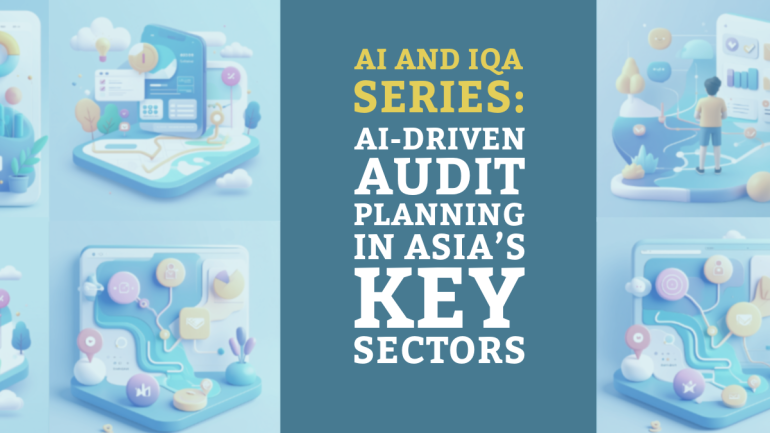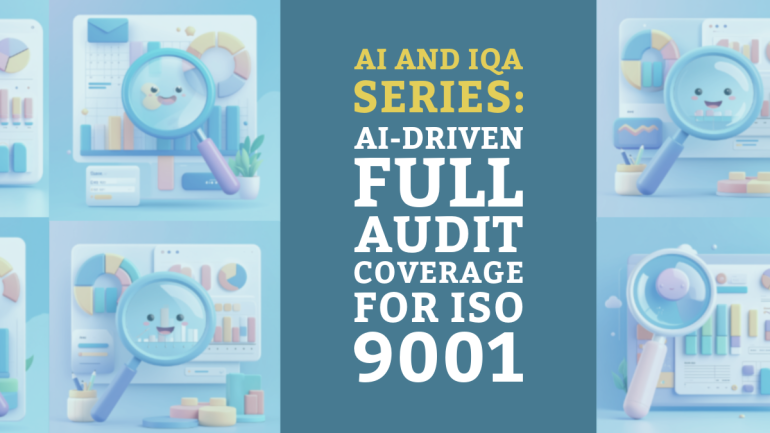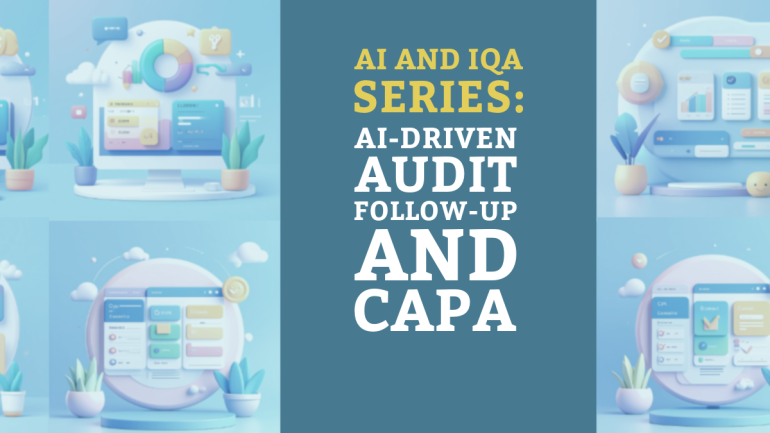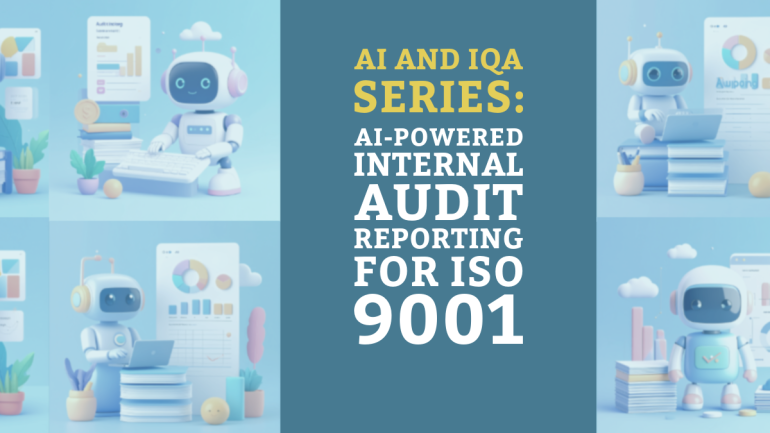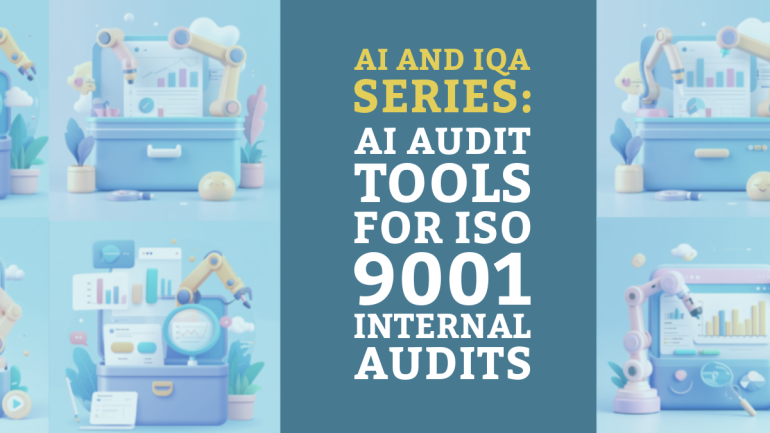This website uses cookies so that we can provide you with the best user experience possible. Cookie information is stored in your browser and performs functions such as recognising you when you return to our website and helping our team to understand which sections of the website you find most interesting and useful.
Table of Contents
TL;DR: Audit Planning with AI
- AI-driven audit planning is helping organizations across manufacturing, healthcare, finance, and education align more closely with ISO 9001 and ISO 19011 standards.
- Real-world examples from Singapore, Japan, South Korea, and Malaysia show AI automating risk assessment, audit scheduling, and resource prioritization, boosting audit effectiveness.
- Significant outcomes include 90% reductions in manual audit steps, 20–30% increases in audit coverage, and thousands of audit hours saved through data-driven, risk-based audit planning.
- Human auditors remain essential for validating AI insights and finalizing audit priorities, ensuring that AI enhances – not replaces – strategic audit judgment.
Artificial intelligence (AI) is increasingly being leveraged in Asia to enhance audit planning across manufacturing, healthcare, finance, and education. In line with ISO 9001’s risk-based thinking and ISO 19011’s guidelines for risk-based audit programs, organizations are using AI to identify high-risk areas, optimize audit schedules, and automate planning tasks. This alignment has yielded measurable benefits – from significant time savings and broader audit coverage to improved risk identification. Notably, a 2024 global survey found roughly 26% of auditors are already using AI in audit activities (with another 36% researching future use). In Singapore, a 2025 poll of 190 governance and audit professionals confirmed that AI tools are being applied to risk assessment and audit planning, though adoption remains relatively low so far. Below we explore real-world examples from 2023–2024 in Asia’s key sectors, highlighting how AI-driven audit planning is being implemented and its outcomes.
Manufacturing Sector: Risk-Focused Quality Audits
Asian manufacturers have begun deploying AI to enhance internal quality management system (QMS) audits in accordance with ISO 9001. The emphasis is on using data analytics and machine learning to drive risk-based audit planning, ensuring audit resources target the most critical production processes and supplier risks. For example, leading Japanese and Singaporean manufacturers are using AI to mine production data (e.g. defect rates, process deviations) and supplier performance metrics to pinpoint areas of high risk. Audit plans can then be dynamically adjusted so that operations with elevated risk profiles get audited with higher priority or frequency. This approach aligns with ISO 19011’s guidance to consider risk and importance when scheduling audits.
- Case in point: Align Technology, an orthodontic device manufacturer, adopted an AI-driven audit analytics platform to bolster its internal audits. The results were striking: a 90% reduction in manual audit work and 100% transaction analysis, eliminating the blind spots of traditional sampling. The AI system continuously flags anomalies in production and financial data, which improved risk response times and allowed the audit team to focus on strategic insights. Auditors noted that the tool “enabled us to automate risk identification and focus on high-value analysis instead of manual sampling.” In short, AI helped ensure that all high-risk transactions and processes were reviewed, greatly strengthening audit effectiveness.
- Data-driven audit scheduling: Another manufacturer in Malaysia integrated AI with its audit management system to optimize audit scheduling. By analyzing machine maintenance logs, safety incidents, and customer feedback in real time, the AI model could predict which factory sites and processes were most likely to have quality non-conformities. Internal audit leaders report this risk-based scheduling has led to more timely audits—scheduling just before predicted spikes in defect rates resulted in a 20% increase in early detection of quality issues. This ensures critical manufacturing sites and processes receive audit attention proportional to their risk, fully in line with ISO 19011’s risk-based allocation of audit resources.
Healthcare Sector: Proactive Internal Audits for Patient Safety
In healthcare (hospitals, clinics, pharmaceutical firms), AI is being applied to audit planning to strengthen compliance with patient safety standards and regulatory requirements. Hospitals in Singapore and Malaysia with ISO 9001-certified quality systems have begun experimenting with AI to analyze vast amounts of operational data—incident reports, clinical outcomes, staff training records—to identify risk patterns that inform the internal audit plan. This is crucial in a sector where patient safety and service quality are paramount.
For example, a large hospital network in Singapore leveraged an AI-based analytics module to support its internal audit scheduling. The AI combs through patient feedback, infection control metrics, and regulatory changes to spot emerging risks. As a result, the internal audit team now updates its audit plan quarterly instead of annually, focusing on units with higher risk scores (such as wards with increased infection rates or departments with many patient complaints). This approach reflects ISO 19011’s recommendation to adjust audit programs based on current risk evaluations. Early outcomes have been positive—a 15% improvement in identifying compliance issues year-on-year, as audits are now targeted to areas flagged by the AI risk indicators.
Finance Sector: Smarter Internal Audit Plans in Banking
Financial institutions in Asia (banks, insurers, fintech firms) have been early adopters of AI in audit and risk management. Internal audit functions in the finance sector deal with massive data volumes and fast-evolving risks, and AI offers a way to enhance both the efficiency and effectiveness of audit planning. In one 2025 APAC survey, 20% cited risk assessment and 19% cited planning as the audit activities that would benefit most from AI agents.
- Continuous risk-based planning: A major Japanese bank implemented an AI-driven audit management system that automatically pulls in enterprise data (transaction anomalies, fraud alerts, market changes) to update its risk assessments. The system suggests changes to the audit schedule—such as moving an audit forward if risk indicators spike—without waiting for the next planning cycle. According to a PwC report, this “continuous risk assessment and testing” feeds into audit planning to prioritize audits based on the latest risk profile (see details), aligning tightly with ISO 19011’s guidance to base audit frequency on risk.
- Efficiency gains and expanded coverage: An investment bank in Singapore piloted a generative AI tool to automate parts of audit planning and fieldwork. By using a custom large language model (LLM) to review contracts and financial records and draft initial testing plans, the bank replaced an estimated 8,000 hours of manual work annually in its audit process. Auditors now validate and refine the AI’s output, redirecting their time to deeper risk analysis rather than rote data gathering. Singapore’s Big Four firms have similarly deployed AI to streamline audit planning, data reconciliation, and document review without reducing headcount.
- Improved risk identification: ML models scrutinize financial trends, market data, and external news to predict potential control breakdowns. One Southeast Asian insurance company focused on the top 15% highest-risk processes identified by its AI risk engine—uncovering major control issues in areas never audited before. AI can also evaluate control test results on the fly, prompting auditors to expand scope or add new engagements when exceptions spike.
Education Sector: Emerging Uses in Academic and Administrative Audits
The education sector is beginning to explore AI for audit planning, though adoption lags other industries. Universities in Asia with ISO 9001 certifications are feeding student feedback, course evaluations, and outcome metrics into ML models. The AI identifies departments or courses with anomalous trends (e.g., consistently poor evaluations), allowing auditors to target those in 2024 rather than adhering to a fixed rotation. This data-driven targeting follows ISO 19011’s advice to consider past performance and risks when scheduling audits.
Administrative pilots in Singapore and Malaysia include AI assistants that roll forward prior audit plans, schedule meetings, and draft initial scopes based on past reports—tasks that once took administrators days, now done in minutes.
It’s also notable that the EU has issued ethical considerations for AI in education, underscoring the importance of oversight. Auditors will both use AI for planning and soon audit AI systems themselves for fairness, privacy, and reliability.
Conclusion
Across Asia, AI is transforming audit planning by aligning programs with ISO 9001 and 19011 principles of risk-based focus and efficiency. Key benefits include:
- Risk-based audit plans: AI pinpoints high-risk areas—manufacturing defects, hospital safety flags, banking anomalies—ensuring audits target where they’re needed most.
- Improved agility: Audit teams update schedules on the fly when AI risk sensors trigger, rather than waiting for annual reviews.
- Efficiency and coverage: Automating data analysis saves thousands of hours and enables 100% data coverage instead of samples.
- Better insights: Continuous anomaly detection and pattern recognition alert auditors to emerging issues earlier, supporting proactive improvement.
While AI handles data-heavy tasks, human auditors still validate and approve plans—ensuring alignment with strategic risks and ISO guidance. Real-world cases show that AI-driven audit planning expands capacity to deliver assurance and insight, fully adhering to rigorous international standards.
FAQs
1. How does AI-driven audit planning align with ISO 9001 and ISO 19011?
AI enables risk-based planning, automates evidence gathering, and continuously monitors risk indicators, aligning with ISO 19011’s guidance for evidence-based, risk-focused programs.
2. What sectors in Asia are adopting AI for audit planning?
Manufacturing, healthcare, finance, and education in Singapore, Japan, South Korea, and Malaysia are leading adoption, with successful pilots and live deployments.
3. What measurable improvements has AI delivered?
Examples include a 90% reduction in manual audit work, 8,000 hours saved annually in finance, and 20% better early detection of quality issues in manufacturing.
4. Can AI fully automate internal audit planning?
No—while AI automates data analysis and prioritization, human auditors must still validate, adjust, and approve plans to ensure strategic alignment.
5. What risks should organizations watch when using AI?
Key risks include over-reliance on AI, bias in models, and weak data governance. Strong human oversight and adherence to ISO principles are essential to mitigate these.
